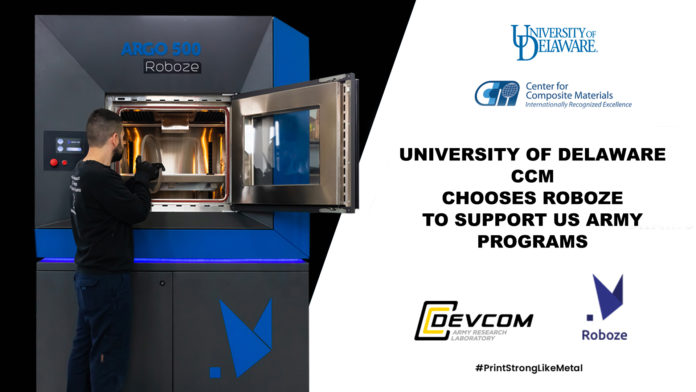A key focus will be made on the manufacturing and supply chain of finished 3D printed parts
Another educational institute that has been convinced by Roboze 3D printing technology is the University of Delaware’s College of Engineering. The Center for Composite Materials (CCM) of this university has chosen Roboze ARGO 500 for its manufacturing activities. The announcement follows Pennsylvania State University’s decision to explore new possibilities for AM of high-performance plastics with ROBOZE One+400 Xtreme.
Acknowledged for its expertise in a number of composites science and engineering areas, the CCM is involved in many research programs, which are supported by a variety of funding sources, including the U.S. Army Research Laboratory (ARL), the Army Research Office (ARO), the Office of Naval Research (ONR) and the State of Delaware to name a few of them.
The addition of Roboze Argo 500 will play a key role in a collaborative research with the Combat Capabilities Development Center US Army Research Laboratory. Focused on Additive Manufacturing of high temperature composite FFF, the program includes two main modules: the development of a modeling and simulation tool that will foster the use of AM parts and part fabrication itself.
According to Roboze, the software tool will draw the ideal path of materials to the 3D printer and will enable to achieve the mechanical and thermal requirements of the desired part. With the goal of rapidly assisting US Army engineers in selecting options to optimize performance of parts, this research program will also enable to foster the use of 3D printed parts in supply chain. Despite the slow and expensive certification and qualification processes, the University has no doubt that this research will be of great benefit for the Department of Defense.
As far as part manufacturing is concerned, Larry R. Holmes, Jr., Assistant Director, Digital Design and Additive Manufacturing at UD-Center for Composite Materials states that while they are working to assist in mainstream acceptance of AM in dod supply chains, there are some missions that have a less rigorous pathway to fielded use. Once such case could be unmanned or autonomous vehicles.
Leveraging Roboze 3D printing beyond this program
In the long run, the 3D printer from the Italo-American manufacturer will also meet other needs such as teaching and research.
“Roboze ARGO 500 was selected for our collaborative efforts. We are especially concerned with repeatability and accuracy, and the ARGO 500 helical rack and pinion hardware (beltless system) can help us provide these qualities. We also required the ability to print high performance materials and require a broad range of thermal profiles to do so. The ARGO 500 can print all of the materials of interest, from standard FFF materials to fiber reinforced high temperature thermoplastics. ” says Mr. Holmes.
“Finally, we want to assure stability of prints when using high temperature materials, so we need to ensure we have control of the build chamber temperature, and the ARGO promises to give us that control. The automatic build plate leveling system and vacuum system within the ARGO were also important aspects in the selection of this equipment.” concludes Mr. Holmes.
Remember, you can post free of charge job opportunities in the AM Industry on 3D ADEPT Media or look for a job via our job board. Make sure to follow us on our social networks and subscribe to our weekly newsletter : Facebook, Twitter, LinkedIn & Instagram ! If you want to be featured in the next issue of our digital magazine or if you hear a story that needs to be heard, make sure to send it to contact@3dadept.com.






